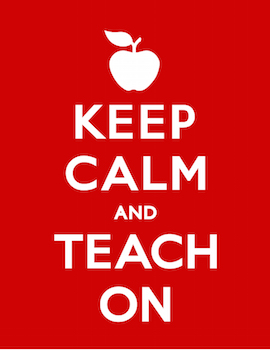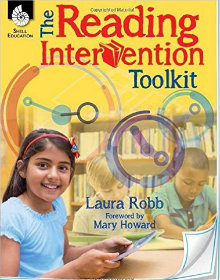Laura Robb’s Back to School Tips for Newbies
 By Laura Robb
By Laura Robb
Several years ago Katie, a lead teacher in a nearby school district, gave me a call. She told me that Lily, a first-year teacher, was anxious about teaching 25 fourth graders in a self-contained class.
Lily had so much anxiety, in fact, that she was frequently staying in her classroom past 8 p.m. Often the custodian had to ask her to leave before locking up the school.
I knew Lily – her parents were friends of mine. I wanted to help, so I agreed to collaborate with Katie. (All the names in my story are pseudonyms.)

Young and bright, Lily wanted to do everything “perfect” for her students. She over-planned and tried to predict each student’s reaction to lessons so she could help them. She clearly needed more help and support.
New teachers can’t be left to sink or swim
Quite often, first year teachers like Lily try to resolve their teaching anxieties by overworking; eventually they dread coming to school. Talking regularly with more experienced teachers, as Katie and I did with Lily, can ease the stress, and at the same time help teachers realize that they can’t prepare for every possible learning situation.
To allay the apprehension of first-year-teachers – as well as the uncertain feelings experienced teachers have upon entering a new school – principals can develop ways to transition them into their schools’ culture. Usually, at a minimum, before regular staff returns, new teachers meet to walk through the school, review the school’s handbook, and discuss schedules.
In addition, schools often pair each new teacher with a mentor, an experienced teacher who meets with a mentee throughout the school year. Many principals and lead teachers also establish an “open door policy” which means they will quickly find the time to discuss issues with teachers.
Knowing that help is available can prevent a lot of frustration and rising anxiety. In fact, these sensible first-year practices can make the difference between a new teacher successfully launched and a frustrated employee considering a career change.
My Tips for New Teachers
The tips that follow are not a substitute for proactive on-site support from August to June. But they will provide new teachers with suggestions that have worked for veteran teachers. My goal is that all teachers will find at least one nugget of advice that they can apply or adapt.
Building Relationships with Mentors
► Meet regularly during the entire school year with the mentor your school assigns. Avoid skipping scheduled meetings. Even though you feel you have everything under control, conversations with your mentor can give you insights into upcoming school events, faculty meetings, parent-teacher conference days, etc.

► Cultivate positive relationships with other teachers and identify those you trust, relate to, and believe can also help you. It can be as simple as meeting for lunch once a week or arriving early one morning to discuss students, schedules, or lessons.
► Ask a teacher you’ve developed a relationship with to be your mentor if your school doesn’t have an organized, well-functioning mentor program. Having a go-to experienced teacher is one of the best ways to ease into your new teaching position.
► Invite a mentor to observe a lesson and provide feedback on what worked and areas that require self-reflection and adjustments. Then, invite the mentor back to observe an updated lesson. Input from others combined with self-reflection can result in real progress. Be brave!
Setting Up Your Classroom
► Evaluate your classroom space and know that how you set up your room reflects your teaching style. Consider clustering students’ desks in groups of four to five so students can discuss lessons and books and provide peer feedback for written work.

► Organize materials for writing so students can get these independently. You’ll also want to have crates or shelves for writing workshop folders and readers’ notebooks.
► Cover your bulletin boards with construction paper and border trim. Then post students’ writing, drawing, and other creative projects. Posting student work not only honors what students do, but it also provides others with models and possibilities, as long as you set aside time for students to read the work that’s on bulletin boards.
Planning Lessons
► Follow your school’s lesson-planning guidelines and ask your mentor to help you complete these until you’re comfortable planning on your own.

► Consider including these three elements, which I incorporate into every lesson plan:.
- Goals: Note one to two goals for the lesson.
- Student Practice: List what students will do; active learning is the heart of the lesson.
- Assessment: This can be notes based on your observations, a writing task, collaborative or individual projects, student-led discussions, guided practice, etc.
Getting Through That First Week
► Begin each day with a read aloud to build students’ interest in literature, tune their ears to literary language, and model how you solve meaning and vocabulary problems.
► Start building a trusting community of learners with these activities:
- Share your interests first and then ask students to complete an interest inventory so you can help students find topics to write about and books that interest them.
- Tell students about your reading life and ask them to write about theirs.
- Have students share with their group a great book they recently read or movie they saw.
- Hold getting-to-know-you conferences with students so to gain insights into what your students enjoy doing outside of school, their hopes and dreams, favorite subjects, books, etc. This enables you to build positive relationships and see each student’s unique qualities.
- Teach students how to self-select independent reading books: books they can read with 100% accuracy and comprehension. Emphasize that these should be easy and enjoyable reads.
- Offer opportunities for reading self-selected books at school.
- Invite students to create a set of behavior guidelines for independent reading and writing.
► Introduce a different area of the room each day.
► Give out materials such as readers’ notebooks, writing folders, instructional reading texts, etc.
Establishing Teaching Routines
► Model and explain what will happen each day your students are in class. Discuss your expectations with them and listen carefully to their comments and feedback. Consider integrating some of their suggestions into your routines.
Read-aloud.
- Review of the daily agenda for the class.
- Distribution of materials such as readers’ notebooks and/or writing folders.
- Mini-lesson.
- Guided practice after mini-lessons.
- Instructional reading and writing.
- Conferring with the teacher.
Working With Parents
► Contact parents early in the school year to report good news about their child. This can be an email or a telephone call.
► Consider writing a bi-monthly or monthly newsletter that celebrates classroom learning experiences and activities. Parents love knowing what their children are doing. In your newsletter provide tips for reinforcing classroom learning at home.

► Let parents know when their child struggles and explain the kinds of support you are offering at school.
► Listen carefully to parents’ concerns. Invite them to come to school to review their child’s work. Explain how you are supporting their child and suggest what they can do at home.
Coping with Your Own Feelings
► When frustrations and anxieties arise, talk about them to your mentor. Often talking through issues can reduce the tension you feel.
► Try to pinpoint the origin of these feelings. Is your stress caused by lesson planning, students’ behavior, not enough time to cover material, parent complaints, frequent changes in daily schedules, etc.? If you can pinpoint the origin of the stress, then you can work with your mentor to relieve it.
► Know that all teachers, new and experienced, feel stress and deal with frustrations. The difference is veteran teachers have developed a menu of coping strategies. Borrow from those menus.
Closing Reflections

You can often whisk feelings of isolation and loneliness away by meeting with new teachers at your school and/or in your district once or twice a month to compare experiences and share stories. Reach out if you need to. You’ll find you’re in good company.
Teaching is a journey, and the travel eases as you gain experience and build a network of colleagues. And remember, all teachers – veteran and new alike – face roadblocks they must learn to overcome. It’s part of the job.
Find more help:
26 of MiddleWeb’s Best New Teacher Resources


 Read-aloud.
Read-aloud.


























